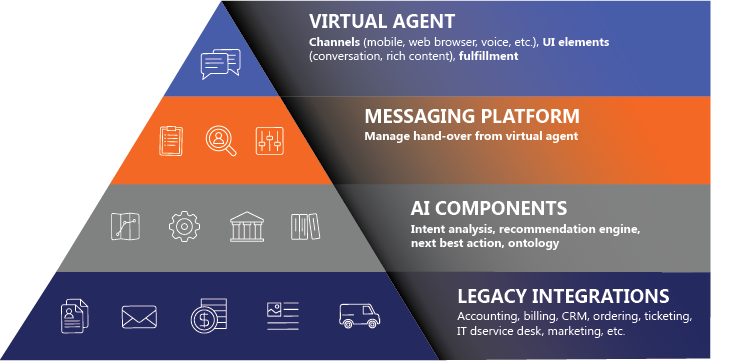7-minute read
With the advent of personalized products and on-call delivery, customers have come to expect a new standard experience: fast, easy, accurate, and personalized. Accomplishing this without sacrificing your workday can be a challenge, since the data processing required to meet these needs is immense. Luckily, virtual agents (VAs), powered by conversational AI, can utilize this information faster and more accurately than humans, finding insights and automating communication to deliver an enriched customer experience. If you invest based on these improvements, you’ll find that implementing these tools delivers a powerful competitive advantage.
The virtual agent advantage
As shown in the diagram below, conversational AI comprises a series of systems. In practice, these interwoven elements allow access to and processing of data for businesses and their customers, creating a seamless and informative conversational experience. At Logic20/20, we understand that all four layers are necessary to produce an effective and long-standing business solution. For businesses and their customers, conversational AI that utilizes the entire pyramid can deliver an array of key improvements.

Benefits of conversational AI
Higher productivity
Automated support is available 24/7 and able to handle simple requests, allowing customer service representatives (CSRs) to respond to concerns more quickly and lowering overall resolution times. VAs also improve employee productivity by enabling human agents to engage in multiple messaging conversations simultaneously and addressing simpler tasks and requests as they arise.
Lower cost of customer care
This is a high-impact benefit for businesses, since customer care carries a high operating cost. Conversational AI can handle requests at a higher volume than humans, provide relevant and correct information faster, and increase accuracy and complexity over time.
Interactive brand messaging
Conversational AI as a brand messenger is woven into our daily lives in the form of Apple’s Siri, Microsoft’s Cortana, and Amazon’s Alexa. VAs allow you to follow this lead, personify your brand, and meet your customers on their preferred channel, moving beyond static display ads, web copy, or paid social to create a truly interactive experience.
Increased tNPS
With conversational AI messaging, brief tNPS surveys can be conducted at the end of a chat, providing a quick and easy way to gauge the quality of your customer’s experience. Even if you choose to query your customers some other way, your tNPS score will improve based on the ease and productivity that virtual agent messaging provides.
Improved employee experience
By taking on simple requests such as resetting passwords and checking delivery status, VAs allow human agents to focus on addressing more complex issues and using their people skills to build customer relationships.
See more benefits of conversational AI
Happy customers
Personalization
Using personalized data like location, preferences, and account history, the machine learning behind conversational AI can create a highly personalized chat experience for every customer. When a virtual agent has established these customer characteristics, it can provide highly relevant information and recommend next steps based on the customer’s best interests and/or wishes. This contributes to upsells and reduces the need for further interaction. When relevant information is gathered and implemented effectively in the customer’s first conversation, their questions can be answered properly, eliminating the need for them to contact customer service a second or third time.
Increased accessibility
Increased availability improves the customer experience before it even begins. Customers can interact where many of them are most comfortable: in mobile chat. They receive answers to their queries instantly and can skip waiting in long phone queues. Virtual agents help them engage in a convenient and easy way.
Generational advantage
While some older customers may still prefer live phone conversations, millennials and Generation Z grew up using text messaging as their primary communication method, and this preference extends into their brand relationships.
So, conversational AI is good for your business and your customers, but how does it work?
Making it happen
Virtual agents monitor customer conversations with CSRs using natural language processing (NLP) and recommend content to support the exchange. They can also support CSRs directly in conversations independent of any customers by answering direct CSR queries. With proper conversational AI training and thorough the integration of resource systems, VAs deliver a smooth and seamless customer experience.
After the machine learning algorithm is created and the basic framework for the virtual agent is established, developers integrate intent detection. Intent detection connects common customer-entered keywords such as hours or returns to specific responses, establishing standard exchanges for the VA to use when it interacts with humans. To accommodate the emotional aspect of human interaction, sentiment analysis helps VAs analyze text for customer state of mind, flagging those that should speak to a human immediately. In action, this allows customers to be routed quickly, minimizing delay and frustration. The process of training these machine learning algorithms develops three important conversational elements:
Complexity. Virtual agents learn to process increasingly complex queries through continuous learning from historical chat and conversation data.
Speed. As their experience grows, VAs can more quickly provide relevant content, tapping into up-to-the-minute data sources and conversational understanding.
Perspective. Machine learning has a uniquely holistic perspective, one comprised of numerous rich and historical data sources. Combined with incredible speed, this perspective allows conversational AI to recognize complex data patterns that humans otherwise may not have found.
Designing an effective virtual agent
As you put conversational AI into practice for your organization, here are a few best practices to keep in mind.
Start by determining the issues your virtual agent will handle.
These might fall under the following categories:
- • Targeted personas (e.g. customer, employee)
- • Questions (e.g. hours of operation, status of an order, etc.)
- • Requests (e.g. rescheduling a flight, resetting a password, etc.)
- • Other communications (e.g. feedback on a purchase)
Come up with “intents” for each issue.
These are representative examples of the text a customer might enter; they do not have to be exact (e.g. “when will my order arrive,” “when will my package get here,” etc).
Create a dialog tree for each issue, with a branch for each scenario.
For example, customers who do not have their order numbers can be routed through an order lookup branch.
Integrate with back-end systems.
This is where most of the work will take place. Ensure that your conversational AI integrates seamlessly with systems such as CMS, sales, shipping, and others that may be required to resolve customer issues.
Build the feedback loop.
Identify how handling of intents and conversations can be improved as more users interact with the VA.
Include end-of-conversation dialogs and human handoff.
For example, the VA might ask “Did this answer your question?” If the customer answers “No,” she can automatically be routed to a human agent.
Use analytics and transcripts to measure performance.
Look at KPIs like engagement rates (percentage of cases where the VA was able to understand what the customer asked and offer a solution), escalations (cases that were routed to human agents), and abandons (cases where the customer exited out of the app before resolving the issue) to identify opportunities for improvement.
Conversational AI and virtual agents are on the forefront of customer service and business operations and are paving the way for many businesses looking to use voice channels in the future. The competitive advantage gained by integrating these tools now can position businesses well as the intersection between technology, industry, and human experience continuous to evolve.

Digital transformation done right
We create powerful custom tools, optimize packaged software, and provide trusted guidance to enable your teams and deliver business value that lasts.

Lionel Bodin is the Director of Digital Transformation at Logic20/20. He manages highly complex, multi-faceted digital programs related to CRM systems, cloud and on-prem implementations, Big Data, and more.

